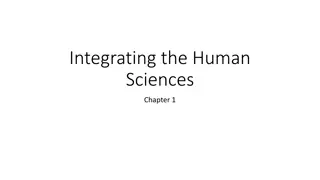Overview of Human Endocrine System in Life Sciences Presentation
This content provides a detailed examination guideline for understanding the human endocrine system in the field of life sciences. It covers essential topics such as the difference between endocrine and exocrine glands, hormone functions, gland locations with functions, and key terminology related to the endocrine system. Diagrams and explanations enhance the learning process, offering insights into the role of hormones, important endocrine glands, and their functions in regulating the body's processes and maintaining homeostasis.
Download Presentation

Please find below an Image/Link to download the presentation.
The content on the website is provided AS IS for your information and personal use only. It may not be sold, licensed, or shared on other websites without obtaining consent from the author. Download presentation by click this link. If you encounter any issues during the download, it is possible that the publisher has removed the file from their server.
E N D
Presentation Transcript
HUMAN ENDOCRINE SYSTEM SUBJECT: LIFE SCIENCES PRESENTER: MAMPOFU N.P. ORTI DISTRICT
EXAMINATION GUIDELINES 2017 HUMAN ENDOCRINE SYSTEM Paper 1: 15 marks Term 3 11 2weeks CONTENT ELABORATION Introduction Difference between an endocrine and an exocrine Definition of a hormone Location of each of the following glands, using a diagram, the hormone they secrete and function (s) of each hormone. Hypothalamus (ADH) Pituitary/ hypophysis (GH,TSH, FSH, LH, prolactin) Thyroid gland (thyroxin) Islet of Langerhans in the pancreas (insulin, glucagon) Adrenal glands (adrenalin, aldosterone) Ovary (oestrogen, progesterone) Testis (testosterone)
TERMINOLOGY Hormone: is an organic chemical, secreted in small quantities by the endocrine glands into the blood stream. Endocrine gland: ductless glands that secrete hormones into the bloodstream. Exocrine gland: glands that do not produce hormones instead they pour their secretion directly into ducts. Target organs: organs which react to specific hormones received through the bloodstream. Coordination: joint linking and working together of systems and activities within the body to bring about a harmonious response. Homeostasis: the process of maintaining a constant optimal internal environment.
Differences Between an Endocrine and an Exocrine Gland Have no ducts/ are ductless. Secrete hormones. Pour their secretions directly into the bloodstream to reach target organs. Have ducts. Secrete enzymes or digestive juices. Pour their secretion directly into ducts e.g. salivary duct of the salivary gland.
HORMONES They are organic chemical messengers which are mostly protein. They are secreted by endocrine glands and carried in the blood stream to their target organs to regulate them and cause responses. Their functions are to: regulate secretions from various glands. Control growth and development of the body. Maintain homeostasis. Regulate metabolism and energy release. Control the process of reproduction.
Hypothalamus located beneath the thalamus in the brain Locations of Locations of some some Important Important Endocrine Endocrine Glands Glands Pituitary gland/ Hypophysis Situated in a small bony cavity on the floor of the skull and connected to the hypothalamus Thyroid gland Situated in the anterior part of the neck where it straddles the trachea, just below the pharynx Islets of Langerhans situated in the pancreas Adrenal gland Situated in anterior end of each kidney Testes (males) situated inside the scrotum, hanging outside the body Ovaries (females) In the uterus (womb)
Functions of Functions of Endocrine Glands Endocrine Glands
A. Pituitary gland It is a pea-sized gland found at the base of the brain. Its posterior lobe is connected hypothalamus, a part of the brain. GLAND/ ORGAN HORMONE(S) FUNCTION TARGET ORGAN Pituitary gland anterior lobe Growth hormone Regulates over all growth of the skeletal muscle. Regulates the growth of thyroid gland and secretion of its hormone, thyroxin. Stimulates the development of follicles in the ovary. Stimulates ovulation and formation of corpus luteum in ovaries. Stimulates mammary glands to secrete milk. Skeletal muscle Thyroid gland Thyroid stimulating hormone (TSH) Follicle stimulating hormone (FSH) Luteinising hormone (LH) Prolactin Mainly ovary Mainly ovary Mammary glands Kidneys Hypothalamus ADH Promotes reabsorption of water in the kidney. The hormone is stored in the posterior lobe of the pituitary gland.
PITUITARY GLAND AS A MASTER GLAND Pituitary gland / hypophysis is given a nickname, master gland because it controls activity of other glands.
THE ENDOCRINE SYSTEM (continues) B. Thyroid gland: it is an H-shaped two lobed gland on either sides of the trachea. GLAND HORMONE FUNCTION TARGET ORGAN Respiring cells Thyroid gland Thyroxin Controls energy production and the basal metabolic rate of all cells. Regulates tissue growth and development in the reproductive and nervous system.
C. ISLETS of LANGERHANS - are found in the pancreas. - Secrete hormones (insulin and glucagon) which regulate the amount of glucose in the blood. GLAND HORMONE(S) FUNCTION TARGET ORGAN Liver, muscles, organs with respiring cells. Islet of Langerhans Insulin Decreases the amount of glucose in the blood by stimulating: respiring cells to absorb glucose. the utilisation of glucose by cells. the conversion of glucose by liver cells and muscles to osmotically inactive glycogen which is then stored in the liver and muscles. Glucagon Increases the amount of glucose in the blood by stimulating the liver and muscles to change stored glycogen to glucose which is then add into the blood Liver, muscles
D. Adrenal glands are found as caps on top of the kidneys. The outer layer is called cortex and the central part is called medulla. The cortex secretes aldosterone and medulla secretes adrenalin.
ADRENAL GLAND (continues) GLAND HORMONE FUNCTION TARGET ORGAN Adrenal gland Adrenalin by constricting the blood vessels to the skin and digestive system to supply them with less blood. increasing the metabolic rate in muscles and brain cells to supply them with more energy so that their activity increases. increasing skeletal muscle tone and sweating. causing pupils to dilate. Aldosterone Regulates the amount of salt in the blood. Assists ADH to regulate the water content of the blood. kidneys
E. GONADS gonads or reproductive glands in females are called ovaries which are found at the end of fallopian tubes. In males they are called testis which are found below the abdomen. Ovary Progesterone and oestrogen GLAND/ ORGAN HORMONE FUNCTION TARGET ORGAN Control development of female sex organ and secondary sexual characteristics. Also control menstrual cycle and pregnancy. Uterine walls Testes Testosterone Controls the development of male sex organs and secondary sexual characteristics. Seminiferous tubules.
ACTIVITY 1. Complete the following table by writing the numbers 1.1 to 1.9 in your answer book and next to each number the correct missing information. (1x9) (9) Gland Position in the body Hormone Function of hormone 1.1 Pituitary gland 1.2 At the base of the brain TSH 1.3 Regulates the growth and functioning of the thyroid gland. 1.4 Thyroid gland Below the larynx 1.5 Thyroxin 1.6 Controls energy production and metabolism in al cells 1.7 Adrenal gland 1.8 On-top of the kidneys 1.9 Adrenal gland Prepares the body for an emergency
2. The graph represents a data comparing the growth rate of boys and girls at different ages. 2.1 Between which years did the growth rate of boys decrease the most? (1) 16-19 2.2.Calculate the decrease in growth rate of boys during the period mentioned in above. (2) 7-0= 7 kg/year 2.3 List TWO hormones involved in human growth. (2) Growth hormone and thyroxin 2.4 At what age, in year, did girls reach their final adult size? (1) At 14 Growth rate of girls and boys at different ages 8 7 6 Growth rate (kg/year) 5 4 1 3 2 0 1 2 3 4 5 6 7 8 10 11 12 13 14 16 18 19 Age(years) Boys Girls























